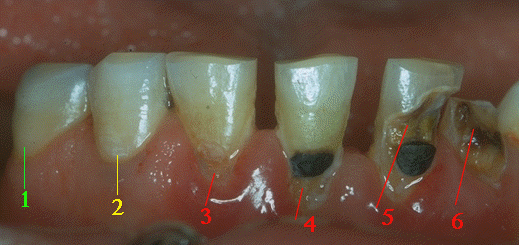
Courtesy: www.info.gov.hk/tooth_club/oral_problem/caries_e.htm
Cavities are the result of a decalcification of the tooth enamel caused by bacteria . "Cavity" refers to the hole in the tooth resulting from infection. The living site of the infection is called a "cary"
Caries are less frequent in populations that have poor nutrition. This is because they cannot afford the sweets that wealthy and western societies can.
In groups such as the Inuit, a sharp increase in number of caries is seen when they switch from their traditional diet to a modern one.
In European countries during WWII, there was a sharp delcline in cary incidence due to sugar shortages.
Presently, fluoridated water has contributed to a dramatic decrease in the number of cavies. Many young adults in America and other countries where this is practiced have not had any cavities. High fluoride consumption in young children can exhibit fluordosis in their adult teeth, which is a mottling of the enamel. This does not have an effect on the susceptability of the teeth to decay.
Saliva is very important in inhibiting the decay process. It acts as a buffer to the acid produced by the bacteria. Saliva also contains a lysozyme-like substance and antibodies that help to control bacteria, but these are not enough to wipeout everything, especially when the bacteria is being fed very well.
(Cawson, Odell 1991)

Caries
usually occur in three areas: in the fissures on the occlusal surface,
on the neck (lingual and buccal), and on the neck between teeth.
The enamel is composed of calcium apatite and very little organic matter. Once the decay gets through this hard outer shell, the other tissues inside, including dentine and the pulp, are rapidly consumed.
Once the decay reaches the pulp, it is called pulpitis, and is the main source of pain associated with caries. Untreated pulpitis leads to death of the pulp and the spread of infection into the periapical tissues. Pulp can also die due to trauma.
The enamel is composed of calcium apatite and very little organic matter. Once the decay gets through this hard outer shell, the other tissues inside, including dentine and the pulp, are rapidly consumed.
Once the decay reaches the pulp, it is called pulpitis, and is the main source of pain associated with caries. Untreated pulpitis leads to death of the pulp and the spread of infection into the periapical tissues. Pulp can also die due to trauma.

1)
No lesions 2) "white spot", some demineralization 3) broken enamel
surface, "lesion" 4) filling surrounded by more lesion
5) demineralization undermining tooth
6)
fracture due to decay
Courtesy:
www.db.od.mah.se/car/data/cariesser.html